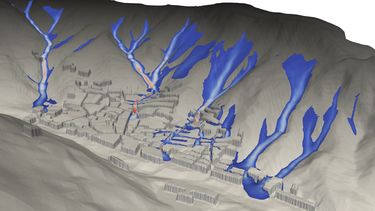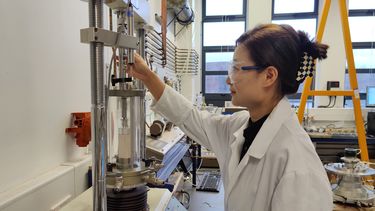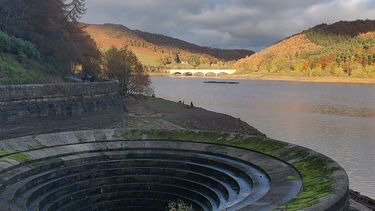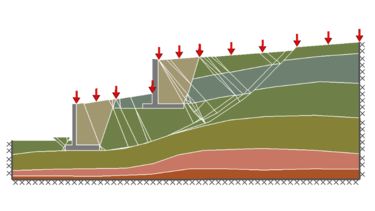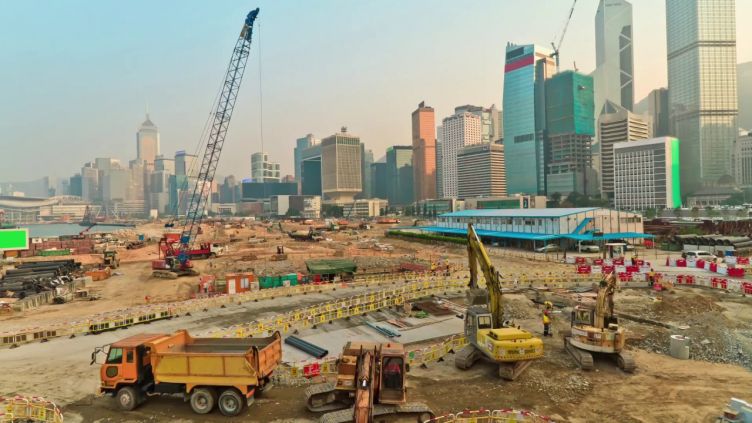Geotechnical Engineering Group
Our research group is dedicated to advancing geotechnical engineering through the development of cutting-edge models and rigorous material testing, contributing to a deeper understanding of soil mechanics and its many applications.

Topics | Projects | Facilities | People
We employ numerical and experimental techniques to investigate a range of practical problems. Our specialist work areas include: geohazards such as landslides, sinkholes and soil instability; optimised design and construction; offshore engineering; physical modelling of geotechnical processes; and soil-structure interaction in masonry arch bridges.
Research Topics
- Landslides and debris flows
-
Our group has specialist expertise on the critical issue of landslides. In the UK this has gained increasing significance in the context of climate change. Understanding the mechanics of landslides is vital for assessing and mitigating their risk. Our laboratory is equipped with a series of specialised flumes designed for modelling landslide runout, offering unparalleled precision in measuring their dynamic processes. Complementing these physical tools are multiphase numerical models that can be applied at various scales, ranging from small-scale laboratory experiments to regional assessments. These tools provide a deeper understanding of landslide mechanisms, and aid in managing and mitigating the risks posed by these natural hazards.
- Soil fundamentals
-
Our advanced testing facilities include stress path triaxial rigs, automatic oedometers, direct shear apparatus, analytical laboratories dedicated to chemical analyses, and a specialised stress path permeameter to measure internal erosion under complex stress states. Additionally, to better understand the effects of climate change on geotechnical applications, we developed a range of equipment to measure total and matrix suction. Such capabilities allow us to investigate wetting and drying cycles, whose consequences are interpreted within the framework of established and emerging constitutive models.
- Dams and internal erosion
-
Dams, crucial for civil engineering, provide water, power, and flood protection. In the UK, over 50% are embankment dams, made from local soil and rock. Modern dam design considers geotechnical, hydrological, structural, and environmental factors. A key concern is internal erosion, responsible for 50% of global embankment dam failures. Sheffield's geotechnical research focuses on suffusion under changing hydraulic loads, studying stress gradient effects, seepage-induced distress in UK dams, 3D flow fields in erodible soil, and stress-hydraulic load influence using a triaxial permeameter.
- Computational analysis and optimization
-
Our group specialises in advanced numerical methods, including multi-scale, multiphase models for assessing landslide risks and computational limit analysis with optimization. Using discrete element (DEM) simulations in our models, we achieve particulate-level resolution of soils and debris, allowing us to study internal mechanisms at the grain scale and their connection to macroscopic phenomena. Computational limit analysis, assuming ideal plastic behaviour, provides rapid and user-friendly tools for ultimate limit state (ULS) design and analysis, aligning with traditional geotechnical engineering methods. Our focus centres on the Discontinuity Layout Optimization (DLO) technique developed in Sheffield in 2007, offering clear failure mechanisms and precise predictions of the margin of safety. Leveraging Sheffield researchers' code and methods, our spin-out company, LimitState, created the widely used LimitState:GEO software for geotechnical applications, available for free academic use globally.
- Physical modelling
-
At Sheffield, our group conducts experiments at single gravity (1 g), utilising flumes for investigating granular and debris flows, a model chamber for testing masonry arch bridges, and a large test facility at the Integrated Civil and Infrastructure Research Centre (iCAIR) for soil-pipe interaction and blast testing. While 1 g testing has its uses, it can be insufficient due to the nonlinear stress-strain behaviour of soil. To address this, we employ our geotechnical centrifuge, a 50 g-tonne, 4 m diameter beam centrifuge, to replicate prototype stress levels and accelerate processes like consolidation and seepage flow. We also have a smaller 'mini-centrifuge' for element testing, offering quick sample preparation and accelerated hydraulic processes, making it suitable for both research and undergraduate teaching.
Current research projects
Recent research projects
Facilities and resources
- Element Test Facilities
-
- GDS controlled 100mm stress path triaxial cells
- GDS thermally controlled 50mm stress path triaxial cell
- ELE controlled 100mm cyclic triaxial cell
- VJ Tech Pro Automatic triaxial, ShearSCAN and ACONS Pro consolidation systems
- Conventional Rowe cells, oedometers and permeameter systems
- Model Test Facilities
-
- Granular flow/debris flumes with high-speed camera capture
- Plane strain model chamber for masonry arch testing, complete with image capture and hydraulic loading capability
- Transparent soil test laboratory with four lasers 500mW – 2000mW for internal imaging within coarse and fine grain soils in model experiments. Examples include visualising internal erosion within a unique flow permeameter or pile interaction studies.
- Geotechnical beam centrifuge: 4m and 1m diameter facilities for research and teaching
- Blast and impact dynamic testing of explosive and hazards at Buxton including: Split-Hopkinson pressure bar for material characterization, testing at strain rates up to 1000/sec and high-speed photography, pulse radiography
- Large scale testing
-
- 45m long by 5m deep by 6m wide test cell at The Integrated Civil and Infrastructure Research Centre (iCAIR), part of the UK Collaboratorium for Research on Infrastructure in Cities.
- Numerical Modelling
-
- State of the art numerical limit analysis modelling capability using LimitState:Geo (including access to enhanced research level features)
- Post-triggering modelling of landslides with in-house depth-averaged software RASH3D
- In-house DEM software for grain-scale simulation of geophysical processes
- Multi-phase investigation of geo-hydraulic processes with DEM-LBM
- Oasys Geotechnical suite
- Itasca FLAC-2D & 3D (with modules)
- FLAC3D
- LS-DYNA
- ABAQUS
People
Academics
| Name | Title |
|---|---|
| Bowman, Dr Elisabeth | Reader in Geomechanics |
| Clarke, Prof. Sam | Professor of Blast Geotechnics |
| Gaspar, Dr Tiago | Lecturer in Geotechnical Engineering |
| Leonardi, Dr Alessandro | Lecturer in Geomechanics |
| Smith, Prof. Colin | Professor of Geotechnical Engineering |

